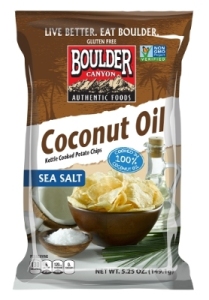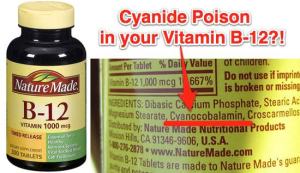How Can You NOT Have Cricket Protein Powder!?

Must be healthy…right?
Hypothetical (or maybe not)… You see something online that talks about an ingredient that recent studies have shown can increase weight loss results. It seems a bit too good to be true and you’ve not heard the claim before, so you move on. A month later, you notice someone post up a link to a Dr. Oz episode where he talks about the weight loss benefits of that same ingredient. Then, a few months later, you start seeing it appear as an ingredient in practically everything at your local grocery store. And in true North American fashion, you jump right on the bandwagon as you seek out anything with that ingredient listed on its nutrition label… an effort not necessary since you’re likely to find it plastered on the front of the box, “Now with 10g of <insert miracle ingredient here>”.

Now with 96 crickets!
So, at what point did you go from skeptic to believer? Was it right after it was featured on Oz? Remember the “Pomegranate” craze? Or the more recent coconut oil movement? Chia, kale, blueberries…they’ve all had a resurgence. Next up, is cricket flour. That’s right… they pulverize crickets into a powder which is cheaper and supposed to be more environmentally friendly source of protein. If it follows the typical “arc” of a food fad, it will start as an ingredient used by a select by “influential” few and quickly grow to find itself on most grocery store shelves, fast food menus and yes… in your cupboard. The unfortunate part is that most of these products will contain either insignificant amounts or will have been so over-processed that the health benefits will have been rendered “dead”.
 How does it happen? How do we become so enamored with a movement that we require it only to be endorsed by “America’s Doctor”… a doctor that I might add has offered recommendations of which only 46% were actually supported by medical evidence (1)? But this isn’t about the popularity of Dr. Oz, it’s about getting caught up in the hype and ignoring fundamental science. First off, I’m a true believer in the advancement of science and not one of those “Hariett Hall” types who find fault in every nutritional idea brought forward after WWII. It comes down to perspective and seeing a bigger picture.
How does it happen? How do we become so enamored with a movement that we require it only to be endorsed by “America’s Doctor”… a doctor that I might add has offered recommendations of which only 46% were actually supported by medical evidence (1)? But this isn’t about the popularity of Dr. Oz, it’s about getting caught up in the hype and ignoring fundamental science. First off, I’m a true believer in the advancement of science and not one of those “Hariett Hall” types who find fault in every nutritional idea brought forward after WWII. It comes down to perspective and seeing a bigger picture.
 The vitamin B12 in its varying forms best illustrates the whole point of this post. Cyanocobalamin is the chemical name given to the most common of three forms of vitamin B12… the other two being hydroxocobalamin and methylcobalamin. Cyanocobalamin has been used in studies for decades and is so safe that it is often used as a placebo in controlled studies. However, recently there have been people and corporations who would have you think that cyanocobalamin produces unsafe levels of cyanide. While cyanocobalamin does in fact contribute to trace amounts of cyanide, according to the Council for Responsible Nutrition, the amounts are insignificant and amount to far less that what one would get from eating an apple (also contains cyanide). The people responsible for the fear mongering are usually selling one of the other two forms or they are simply overzealous health fanatics who live off of having the reputation of being on the cutting edge of science. Specializing in natural weight loss, natural performance and natural anti-aging protocols, I drive myself to be on the cutting edge as well, however, I would never let that drive cloud my vision of the truth, no matter how much it may contradict my wants or needs.
The vitamin B12 in its varying forms best illustrates the whole point of this post. Cyanocobalamin is the chemical name given to the most common of three forms of vitamin B12… the other two being hydroxocobalamin and methylcobalamin. Cyanocobalamin has been used in studies for decades and is so safe that it is often used as a placebo in controlled studies. However, recently there have been people and corporations who would have you think that cyanocobalamin produces unsafe levels of cyanide. While cyanocobalamin does in fact contribute to trace amounts of cyanide, according to the Council for Responsible Nutrition, the amounts are insignificant and amount to far less that what one would get from eating an apple (also contains cyanide). The people responsible for the fear mongering are usually selling one of the other two forms or they are simply overzealous health fanatics who live off of having the reputation of being on the cutting edge of science. Specializing in natural weight loss, natural performance and natural anti-aging protocols, I drive myself to be on the cutting edge as well, however, I would never let that drive cloud my vision of the truth, no matter how much it may contradict my wants or needs.
 So before you go jumping on the bandwagon of the next cutting edge nutritional findings, gain some perspective. While keeping an open mind, step back and consider all the evidence and if necessary, seek out someone you trust for advice. Most of all, just remember… embrace change but don’t demand it. Eat well… mostly. And always energize your soul with whatever drives you. Do that, and you’re one step closer to being One Healthy Bugger!
So before you go jumping on the bandwagon of the next cutting edge nutritional findings, gain some perspective. While keeping an open mind, step back and consider all the evidence and if necessary, seek out someone you trust for advice. Most of all, just remember… embrace change but don’t demand it. Eat well… mostly. And always energize your soul with whatever drives you. Do that, and you’re one step closer to being One Healthy Bugger!
How much does it cost and how often do I come to see u
I would like to know if you have looked into the use of cyanocobalamin and it’s potential negative effects on the methylation cycle? Dr. Ben Lynch has on numerous occasions brought this up during his lectures and has backed it up with research. To me, I would rather my patients invest in methyl or adenosyl forms depending upon their clinical presentation.
In truth, I have not looked at that aspect but would be interested in the findings if you have any links handy. Otherwise, I’m sure if I do a quick search for Dr. Lynch’s site, I’ll find links to clinical info. Sounds like something that may be gaining some traction though.